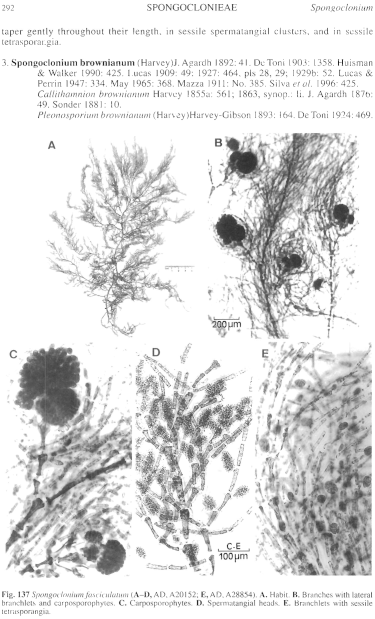|
|
|
|
|
|||||||||||
|
Electronic Flora of South Australia Species Fact Sheet
Phylum Rhodophyta – Order Ceramiales – Family Ceramiaceae – Tribe Spongoclonieae
Selected citations: De Toni 1903: 1358. Lucas 1909: 49; 1927: 464, pl. 27.
Thallus (Fig. 137A) erect, medium to dark red-brown, 10–30 cm high, irregularly branched (Fig. 137B) with one to a few main axes and strongly developed main laterals, densely corticated in mid and lower parts but branches ecorticate for many cells below their apices. Holdfast rhizoidal, 5–12 mm across; epilithic or on Amphibolis. Structure. Axial cells 50–120 µm in diameter near apices, 130–250 µm in diameter below and L/D 2–7, longer basally within the cortication; each axial cell bearing a single, spirally arranged, ecorticate, basally branched, branchlet, often clustered or fasciculate but readily denuded in parts, tapering from 10–22 (–30) µm in diameter basally, cells L/D 4–6, to 8–13 µm in diameter, cells L/D 4–5, near their apices; cortical rhizoids (10–) 20–40 µm in diameter, cells L/D 4–6. Cells multinucleate; rhodoplasts discoid.
Reproduction: Gametophytes dioecious. Carpogonial branches 4-celled, borne on the subterminal cell of short, lateral, 3-celled branchlets, with the third cell bearing 2 sterile periaxial cells; the 3 sterile cells enlarge and become rounded. Following fertilization, the auxiliary cell produces successive, rounded, gonimolobes (Fig. 137B, C) 130–350 µm across with carposporangia 10–20 µm in diameter, and a loose involucre of filaments develops from axial cells below the carposporophyte. Spermatangial heads (Fig. 137D) are borne on cells of branchlets in the mid to upper thallus. Each head is sessile (without a stalk cell), 50–70 (–90) µm long and 40–50 µm in diameter, with an axis of 6–8 (–10) cells bearing whorls of cells and ultimate spermatangia 2–3 µm in diameter.
Tetrasporangia (Fig. 137E) occur on branchlets in the mid and upper thallus, sessile, subspherical to slightly ovoid, (20–) 40–50 µm in diameter, tetrahedrally divided.
Type from Port Phillip Heads, Vic. (Wilson); holotype in Herb. Agardh, LD, 18629.
Selected specimens: Hopetoun, W. Aust., drift (Gordon, 20.xi.1968; AD, A34165). Elliston Bay, S. Aust., 10–12 m deep (Shepherd, 24.x.1969; AD, A34949). N Spencer Gulf, S. Aust., 9 m deep (Shepherd, 13.ix.1973; AD, A44195). Dany Beach, Corny Point, S. Aust., drift on Amphibolis (Womersley, 15.x.1989; AD, A59891). Tapley Shoal, Edithburg, S. Aust., 18 m deep (Shepherd, 2.ii.1969; AD, A33522). Brighton, S. Aust., drift (Bienert, 12.xi.1965; AD, A29675 - "Marine Algae of southern Australia" No. 395). Port Noarlunga, S. Aust., 24 m deep (Ottaway, 3.ii.1981; AD, A51992). Encounter Bay, S. Aust., drift (Wollaston, 2.xi.1965; AD, A29890). Vivonne Bay, Kangaroo I., S. Aust., drift (Womersley, 14.i.1948; AD, A6868). Pennington Bay, Kangaroo I., S. Aust., drift (Wollaston, 11.ii.1956; AD, A20152). Robe, S. Aust., drift (Womersley, 11.xii.1969; AD, A34866). Port MacDonnell, S. Aust., drift (Womersley, 16.x.1985; AD, A56999). Crawfish Rock, Westernport Bay, Vic., 4 m deep (Watson, 17.xi.1974; AD, A46242). Low Head, Tas. (Perrin, Feb. 1940; AD, A9045).
Distribution: Hopetoun, W. Aust., to Westernport Bay, Vic., and the N coast of Tasmania.
Taxonomic notes: The holotype of S. fasciculatum, as for all herbarium specimens of the species, adheres closely to paper and is difficult to study; it appears to be a somewhat denuded cystocarpic specimen.
S. fasciculatum is closely related to S. conspicuum, differing in being less strongly corticated with upper branches largely ecorticate, in having more fasciculate branchlets which taper gently throughout their length, in sessile spermatangial clusters, and in sessile tetrasporangia.
References:
AGARDH, J.G. (1894a). Analecta Algologica. Cont. I. Acta Univ. lund. 29, 1–144, Plates 1, 2.
DE TONI, G.B. (1903). Sylloge Algarum omnium hucusque Cognitarum. Vol. 4. Florideae. Sect. 3, pp. 775–1521 + 1523–1525. (Padua.)
LUCAS, A.H.S. (1909). Revised list of the Fucoideae and Florideae of Australia. Proc. Linn. Soc. N.S.W. 34, 9–60.
LUCAS, A.H.S. (1927). Notes on Australian marine algae. IV. The Australian species of the genus Spongoclonium. Proc. Linn. Soc. N.S.W. 52, 460–470, Plates 27–35.
The Marine Benthic Flora of Southern Australia Part IIIC complete list of references.
Publication:
Womersley, H.B.S. (24 December, 1998)
The Marine Benthic Flora of Southern Australia
Rhodophyta. Part IIIC. Ceramiales – Ceramiaceae, Dasyaceae
©State Herbarium of South Australia, Government of South Australia
Illustration in Womersley Part IIIA, 1998: FIG. 137.

Figure 137 enlarge
Fig. 137. Spongoclonium fasciculatum (A–D, AD, A20152; E, AD, A28854). A. Habit. B. Branches with lateral branchlets and carposporophytes. C. Carposporophytes. D. Spermatangial heads. E. Branchlets with sessile tetrasporangia.

|
Email Contact: State Herbarium of South Australia |

|